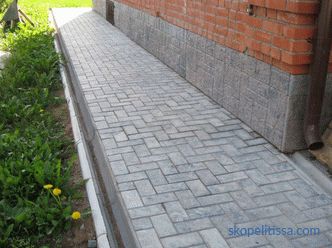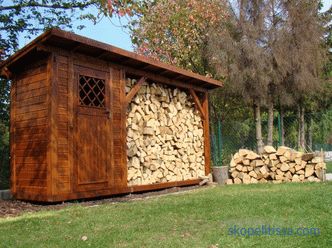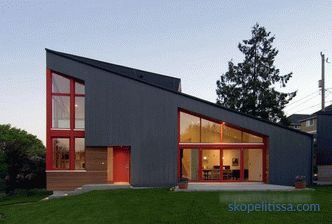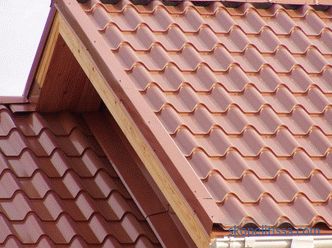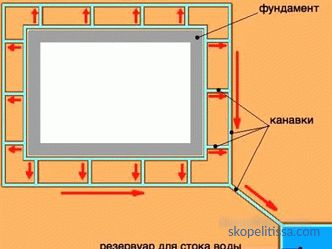A greenhouse with high-quality heating allows you to grow various plants at any time of the year. Heating greenhouses can be implemented by several techniques using different heat transfer fluids. When choosing an option, it is necessary to take into account the purpose of the greenhouse, the size and available energy resources.
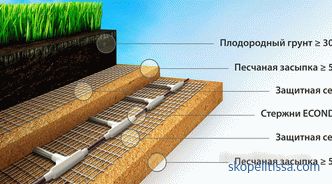
It is necessary to calculate which heat carrier will be economically beneficial for the installed greenhouse or structure to be erected. Consider the availability of energy resources and their cost, in which periods the greenhouse will be operated - only in spring and summer or all year round. When choosing a stove, one must remember about the functionality of the design and thermal power. By making the right calculations and using high-quality materials, you can get an excellent and durable result. Thanks to even a small greenhouse, you can provide yourself with fresh greens and vegetables all year round. When installing large greenhouses, you can start your own business.
Heating options
Most heating systems are powerful enough and should be used only in those structures that are used not only in early spring, but throughout the year.
Common heating methods :
-
furnace;
-
heating cable;
-
gas gun;
-
water;
-
boiler;
-
electric heaters.
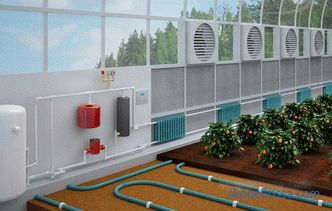
Gas guns are considered a good method of heating, which have the small sizes, quickly warm up the room with the minimum fuel consumption, are safe in operation and are very effective. Using electricity, the main element of heating is recommended to use infrared heaters that do not dry the air. For year-round and large greenhouses, it is preferable to use brick kilns, as they heat longer, but keep heat well and then cool for a long time, maintaining a stable temperature. The air will not dry up, the humidity remains at the required level. The metal heats up quickly, but as long as there is a fire, and such a furnace has a small heat capacity, it dries the air, it is additionally recommended to use a water circuit.
Metal furnaces
Recommended for greenhouses used in spring and summer. They have certain features that make them a better option than brick models:
-
mobility and can be used for several months and then it can be removed;
-
the foundation is not required, occupy a minimum of space;
-
advantageous cost of material;
-
ability to connect water circuit ;
-
simple and fast installation.
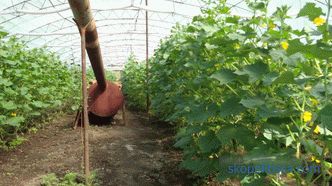
However, it is impossible to automate processes and it is necessary to heat manually, installation is required containers with water. The installation of the furnace is carried out inside the structure or in a separate room with the output circuit. The chimney can be located in the greenhouse, a slope of at least 15 degrees. For this purpose, a non-insulated metal pipe is used, for the exit, heat-insulated boxes are installed in the roof.
The installation of the furnace is carried out in several stages :
-
preparation of the base;
-
installation of the furnace on the base ;
-
chimney connection using heat-resistant sealant; no narrowing of the chimney should be allowed;
-
contour connection, if required.
Furnaces that are equipped with a water heat exchanger must not be operated without a full system.
Brick kilns
Heating for the greenhouse using a brick stove is used mainly for year-round use. This model of heating is effective even in very cold weather due to its high heat capacity. Any oven can be used, but its heat output is fully consistent with the heated area.
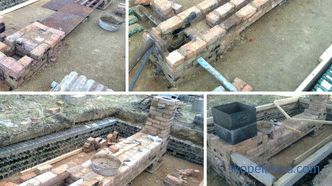
Brick laying is carried out according to the following scheme:
-
creating a high-strength foundation with reinforcement, part of the soil is removed, the bottom is covered with sand, formwork is made, it takes at least three weeks to dry, the surface must be constantly moistened;
-
masonry firebox, ashpit, smoke channels.
The laying stage has its own complexities and peculiarities, therefore, you must entrust the work to a qualified specialist who has the relevant experience. In the process, it is necessary to install the doors, flaps.
On our site you can find contacts of construction companies that offer the installation of furnaces and fireplaces. Directly to communicate with representatives, you can visit the exhibition of houses "Low-rise Country".
Water heating
This option can be realized with several options - installing a separate boiler or connecting to a house system. In the second case, a separate circuit is made to turn it off and drain the water. If a separate system is mounted, then it will be necessary to install the boiler taking into account affordable and beneficial fuel.
Gas models are the most convenient and economical, they can maintain the desired temperature. Combustion products are derived from a coaxial chimney. Solid models can have different modifications. It is also an economical option, but there is almost no possibility of automation and constant monitoring is necessary. Electric automation models that maintain temperature around the clock have great automation indicators. They are small, safe and completely silent. However, there is a minus - the cost of electricity.
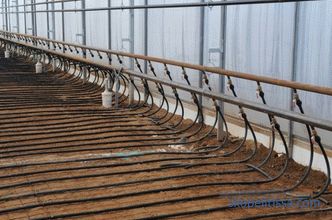
Such heating in a greenhouse occurs according to one scheme regardless of the boiler. You must have the following elements :
-
filters, safety group, pump;
-
radiators, pipes, expansion tank;
-
balancing valve;
-
heat accumulator.
The connection is made as follows:
-
Boiler . It is recommended to place in a separate special room for solid fuel models, others are located in the greenhouse itself.
-
Chimney . Only for gas and solid models.
-
Radiators . Heating elements.
-
Buck . Used for forced system, installed in front of the pump or exit from the boiler.
-
Security Group . Includes air vent, valves, pressure gauges, manifold and couplings. It is installed behind the boiler, where the highest rates of pressure and temperature are noted.
-
Pump . Maintains pressure throughout the system, is mounted in front of the boiler on the return pipe.
-
Pressure testing by air.
If the system has passed the test, then the coolant is poured into the boiler and the test run is performed, the air is released, and balancing is performed.
For a water-heated floor in a winter greenhouse, see the video:
It might be interesting! In the article next link read about the winter greenhouse.
Choosing the optimal boiler
It is necessary to choose the boiler model taking into account the size of the established greenhouse, as well as the crops grown. If there is gas, then it is better to use gas models. For year-round models, solid fuel boilers are a good option. For small greenhouses with periodic use installation of a solid fuel boiler will not work. It is much more profitable to put an electric low-power. It does not require a place and the construction of the chimney, the cost of electricity is minimal.
When using radiators, a number of calculations are required. To achieve a good result and maintain a constant microclimate, you should consult a specialist. In this case are counted:
-
dimensions of buildings;
-
thermal power ;
-
number of radiators.
Sections should be distributed throughout the greenhouse in several rows. It is better to stop the choice on low radiators for good heating of the soil.
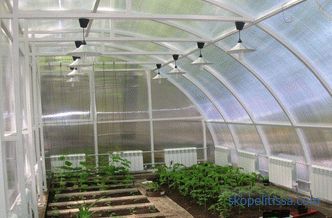
It might be interesting! In the article on the following link read about polycarbonate greenhouse installation.
Electric heating
Basically, special infrared heaters are used, they heat the soil, maintain the temperature and are distinguished by minimal costs. Sometimes other options may be used. The calculation should be carried out by a specialist taking into account all the features of the greenhouse and plant varieties. Elements are evenly distributed throughout the room. Selected models are hung from the ceiling and connected to the network. When using temperature sensors, you can fully automate the heating process and save additional funds.
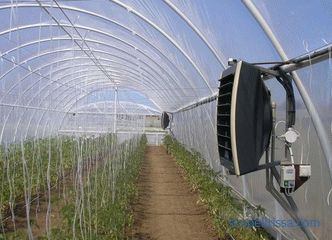
Solar batteries and biological heating
If you are interested in the simplest heating of the greenhouse, then you should choose solar batteries. This is the cheapest option, which uses only the energy of the sun. The greenhouse is located on an open area, where there is no shade from other buildings or trees. The greenhouse itself is built from a polycarbonate with a cellular structure, creating a greenhouse effect.All cells are isolated and there is air in them. Glass can also be used. The greenhouse should be built arched type, and it should be located on the line east-west.
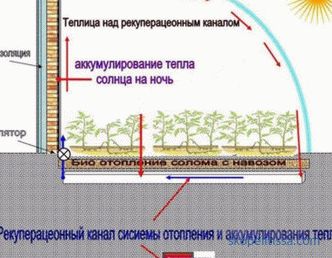
The following work is carried out around the greenhouse:
-
digging a hole ShhG 30H40 cm;
-
fit insulation, for example, polystyrene foam;
-
sand is poured, on top of the film and the ground.
The design accumulates heat, however this method can only be used on sunny days.
The second option is biological materials and the principle of their decomposition. It is often used horse manure, it heats up to 70 ° C and maintains this temperature for at least 4 months. Straw is added to reduce the temperature.
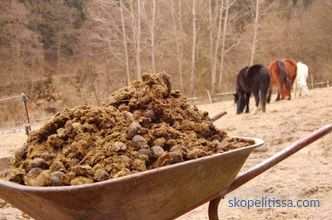
It might be interesting! In article on the following link read about PVC greenhouses pipes.
Cable heating
Does not occupy the area inside the structure, the cable is laid as for a heated floor, warms the soil well, allows you to maintain different temperature conditions, which increases the yield. Differs in easy installation and simplicity of adjustment of temperature conditions with the minimum electricity consumption. Mainly used in industrial greenhouses.
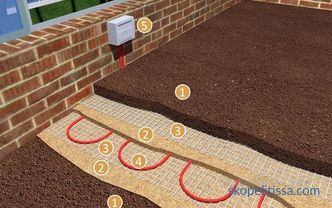
Heat Guns
Considered a simple option without the need for development and introduction of complex structures. Suspended from the ceiling and connected to the network, after which it can be immediately used. The air does not harm the plants, is distributed by the fan. There are different types of guns that are powered by gas, diesel or electricity.
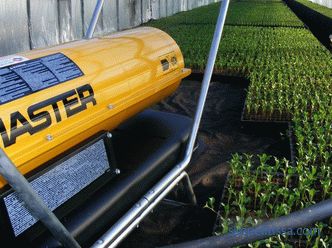
Air heating
A primitive version with the installation of a pipe that is displayed in greenhouses, and on the other hand the fire is turned on. The length of the pipe should be at least 3 m, and the diameter should be 30 cm. The pipe can be made longer and it can be perforated additionally, held further inwards for greater effect. The big disadvantage is the need to constantly maintain the fire, so the option is mainly used as an emergency. Such a heating system does not heat the ground, as the pipes are mounted under the ceiling to protect the plants from hot air.
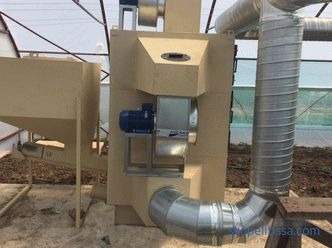
Heat fans
Can be installed fan for air distribution, which eliminates the need to install a pipe system. The air warms up quickly enough, the fan can be moved all over the greenhouse or install several pieces. However, very hot air streams can burn the plants, and the fan itself is able to heat small areas, so installation of several fans that consume a lot of electricity is required.
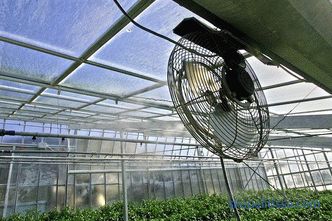
A good greenhouse with correct calculations will allow anyone who wants to, not only grow greens and vegetables for your table, but also run your own business. Materials and technologies will allow to operate the greenhouse all year round, even in extreme cold. But the main requirements remain a good heating system and lighting, the only way to get a good result.
Modern advances and industry offer a large selection of ways to heat greenhouses. Some options are only suitable for warm regions, others may apply all year round. They differ in installation features, costs, fuel used. When choosing a heating option, it is necessary to carry out certain calculations, take into account the area of the greenhouse and the crops grown. Greenhouse can be used not only for seedlings or early harvest, but also for cultivation of flowers and seedlings.
Additionally, the greenhouse can be equipped with automatic irrigation and temperature control systems.
The option of combining furnace heating and fans in the following video:
Also on our website you can find contacts of construction companies that offer winter arrangement services gardens Directly to communicate with representatives, you can visit the exhibition of houses "Low-rise Country".
Conclusion
It is very important when building a greenhouse, choosing a heating system, plants and heating elements, be sure to consult with experts on all issues. Remember that the slightest mistake can lead to negative results - poor harvest and slow plant development.It is also important to choose the right materials from which the structure will be built. Consider absolutely all the factors that may affect the operation of the greenhouse. Consider which heating option is best for you, available resources and fuels.
